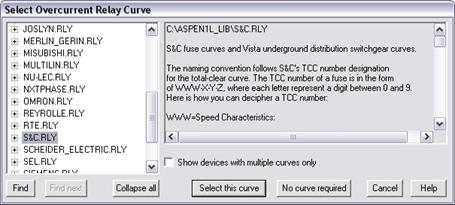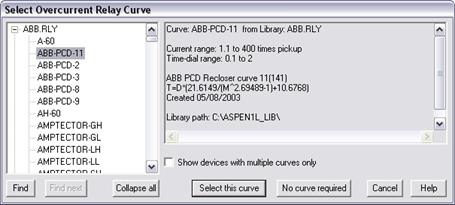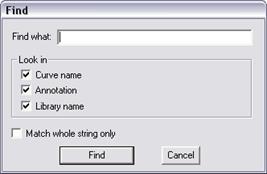
The Curve Selector is used within the dialog boxes for a relay, fuse or recloser to help you select a curve. The Curve Selector dialog box looks like this:

The tree list on the left-hand side of the Curve Selector dialog box shows a complete list of overcurrent curve library files in the Library Directory. (You can change this Library Directory with the OneLiner/Power Flow Configuration Program.) The library files distributed by ASPEN are named after the manufacturer of the protective devices. Any custom library files you created and copied to this directory are also listed.
The panel on the right hand side displays detailed information on the entry you highlighted in the tree list. If you highlighted a file name, such as S&C.RLY, the right-hand panel will show you the naming convention for all the fuse curves that are within that file. See picture above.
If you click on ‘+’ next to a file name and highlighted a curve name, the right-hand panel will show the current range, time dial range, drawing number, equation, and other information for that curve. See picture below for an ABB recloser.

Mark the ‘Show devices with multiples curves only’ check box to omit from the tree list curves that have a single time dial. This option is useful for hiding recloser curves, most of which have only a single curve with time dial of 1.0.
FOR OVERCURRENT INSTANTANEOUS/DEFINITE TIME RELAY ELEMENT ONLY:
Click on ‘No curve required’ to create an instantaneous relay with possibly an “instantaneous delay”. The Curve Selector will disappear. The name ‘N/A’ will be copied to the curve-name edit box.
FOR RECLOSERS ONLY: TO SPECIFY THAT THE CURVE IS NOT NEEDED IN THE PHASE OR GROUND UNIT:
A recloser has four curves: two curves for the phase unit and two curves for the ground unit. One or more of these curves are not needed when (1) the phase or ground unit has a slow curve but no fast curve, or (2) you are using only the phase unit but not the ground unit of the recloser, or vice versa.
Click on ‘No curve required’. The Curve Selector will disappear. The name ‘N/A’ will be copied to the curve-name edit box.
TO SELECT A CURVE:
Highlight a curve name in the tree list.
Note: You can use the Find command to locate the curve you want to use.
TO LOOK UP A RELAY CURVE USING KEYWORD:
Click on Find. A dialog will appear to help you locate the curve.

Enter in the edit box the keywords you are seeking.
Specify search options: look for keyword in the curve name, the curves’ annotation and/or the library name.
Select check box ‘Match whole string only’ to ignore partially matches.
Click on Find.
The Find dialog will disappear. The program will look for the keywords in all the .RLY files in the Library Directory. If the program locates a curve, it will highlight its name in the Curve Selector.
Click on ‘Find next’ to find the next match.
Once you located the curve you want, click on ‘Select this curve’.
The selected curve name will be copied to the curve-name edit box within a relay, fuse or recloser dialog box.